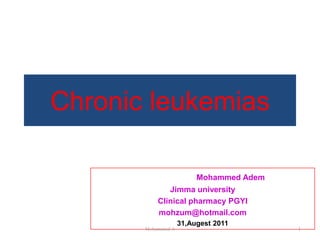The document provides an overview of chronic leukemias, focusing on chronic myeloid leukemia (CML). It defines CML and describes its epidemiology, etiology, pathogenesis, clinical presentation, diagnosis, and treatment. CML results from a genetic abnormality that fuses the BCR and ABL genes. It progresses through chronic, accelerated, and blast crisis phases if left untreated. Treatment options include stem cell transplantation, chemotherapy with tyrosine kinase inhibitors like imatinib, and management of symptoms.






















![Outcome of SCT depends on:
• the patient (e.g., age and phase of disease);
• the type of donor [e.g., syngeneic (monozygotic twins) or
HLA-compatible allogeneic, related or unrelated];
• the preparative regimen (myeloblative or reduced
intensity);
• posttransplantation treatment.
Mohammed A 23](https://image.slidesharecdn.com/mohammedchronicleukemia-130402153958-phpapp01/85/chronic-leukemia-23-320.jpg)
































